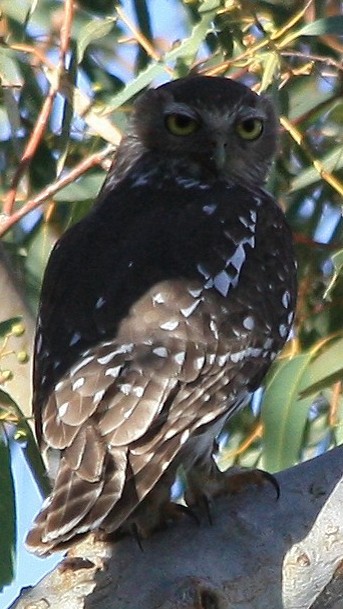Barking Owl
A species of Asian and Australasian Hawk-owls and Boobooks Scientific name : Ninox connivens Genus : Asian and Australasian Hawk-owls and Boobooks
Barking Owl, A species of Asian and Australasian Hawk-owls and Boobooks
Botanical name: Ninox connivens
Genus: Asian and Australasian Hawk-owls and Boobooks
Content
Description General Info
 Photo By timrudman , used under CC-BY-NC-4.0 /Cropped and compressed from original
Photo By timrudman , used under CC-BY-NC-4.0 /Cropped and compressed from original Description
The barking owl is coloured brown with white spots on its wings and a vertically streaked chest. They have large eyes that have a yellow iris, a discrete facial mask and yellow skin on the feet. Their underparts are brownish-grey and coarsely spotted white with their tail and flight feathers being strongly banded brown and white. They are a robust, medium-sized owl 390–440 mm (15–17 in) long and their wingspan is between 850 and 1,200 mm (33 and 47 in). They weigh between 380 and 960 g (13 and 34 oz). Size varies only slightly between the male and female birds with the male barking owl being 8-10 % heavier. They are one of only a handful of owl species exhibiting normal sexual dimorphism. In a banding study conducted in the Pilliga forests of northern New South Wales, males averaged 824 g (29.1 oz) with females averaging 745 g (26.3 oz). In Australia, the smallest barking owls are found on Cape York Peninsula and the largest in southern Australia. 
Size
44 cm
Nest Placement
Tree
Feeding Habits
Barking Owl has a diverse diet, feeding on ground-dwelling mammals like rabbits, possums, and smaller creatures such as sugar gliders, to airborne bats and birds, including large cockatoos and ducks. It also consumes insects, with beetles and moths caught mid-flight, not discounting occasional frogs, reptiles, fish, or crustaceans. Typically hunting from perches, anything detectable and size-appropriate is potential prey.
Habitat
The barking Owl is a forest-dwelling species typically inhabiting varied wooded environments including lowland riparian forests, woodlands, savannas, and dry open sclerophyll forests. Preferentially residing near forest edges, these birds are often found in areas with abundant riparian vegetation close to water bodies like swamps, lakes, and streams. They roost in the canopy or mid-storey foliage and sometimes in tree hollows, frequently forming pairs or family groups.
Dite type
Carnivorous
General Info
Feeding Habits
Bird food type
Distribution Area
The barking owl lives in mainland Australia along the eastern and northern coast of the continent and the southwest areas surrounding Perth, Western Australia. Inland they occupy areas near lakes and waterways or other wooded environments. They also live in drier parts of New Guinea and the Moluccas (Halmahera, Morotai, Bacan and Obi). Once widespread, barking owls are now less common in southern mainland Australia. They choose to live in forests or woodland areas that have large trees for nesting and foliage cover for roosting. They often reside near river, swamp or creek beds as these features often have large trees with hollows required for nesting and the productivity to support sufficient prey. The only detailed studies of barking owl home-ranges have been conducted in southern Australia where the species is declining. In northern Victoria, barking owl pairs were found to average a home-range of 1,424 ha (3,520 acres) with little overlap between pairs. Foraging was concentrated within forested areas of each home range. These results are mirrored in the Pilliga forests of Northern NSW although there the home ranges were larger, often up to 2,500 ha (6,200 acres). Although barking owls are uncommon and sometimes even rare in many suburban areas, they occasionally do get accustomed to humans and even start to nest in streets or near farm houses. 
Species Status
Barking owls are not listed as threatened on the Australian Environment Protection and Biodiversity Conservation Act 1999. However, their conservation status varies from state to state within Australia. For example: The barking owl is listed as 'Threatened' on the Victorian Flora and Fauna Guarantee Act (1988). Under this Act, an Action Statement for the recovery and future management of this species has been prepared. On the 2007 advisory list of threatened vertebrate fauna in Victoria, the barking owl is listed as endangered. The barking owl is listed as 'Vulnerable' under the NSW Threatened Species Conservation Act 1995. This listing was transferred to the equivalent schedules under the NSW Biodiversity Conservation Act (2016) from August 2017. The Action Plan for Australian Birds 2010 lists the barking owl southern sub-species as 'near threatened'. 